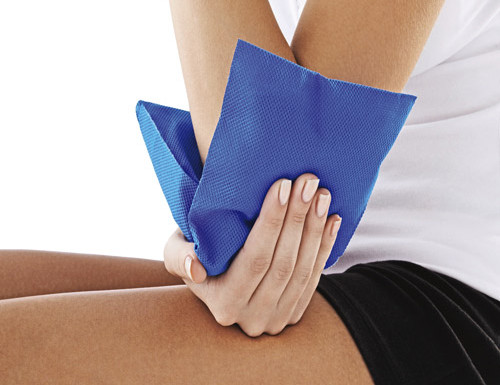Has a weekend of skiing left you sore and stiff? Did you have a fall and bang your knee? These types of aches and pains often appear and it is very common to use hot and cold therapy to treat them. It's the most common type of non-addictive and non-invasive pain relief therapies for aches and pains. The one you use depends on the type of injury.
Often a new injury is treated with cold therapy to decrease blood flow hence decreasing inflammation and swelling. For recurring pain, hot therapy will help increase blood flow to the area to promote healing. 
Cold Therapy
When you have any strain, sprain or bruise, there will be some bleeding into the underlying tissues. This often leads to pain and swelling. Using cold therapy (ice/ice packs) for soft tissue injuries can make the healing process faster and it may also be used in later rehabilitation.
The reason for using cold therapy for immediate treatment is to limit the body's response to injury. Cold therapy can:
- Reduce muscle pain and spasms
- Reduce bleeding in soft tissues
- Reduce pain by numbness in the area
- Prevent or reduce swelling and inflammation
Cold therapy may also enhance the effects of other treatments, such as exercise for reducing muscle spasms and pain. By using cold therapy, it will allow better movement. If you are doing exercise as a part of rehabilitation, you may apply ice pack before beginning your exercise, or you may opt to keep it in place during your exercise. This will reduce the pain and hence will allow for better movement with the injury.
When to Use Cold Therapy
All cold treatments should be used as soon as possible. It is suggested to use it within 24 to 48 hours of an injury. Use cold therapy if you have suffered recent acute inflammation (tissue damage) which includes strains, sprains, bumps and bruises from heavy lifting or sports. Sometimes using cold therapy will relieve pain for chronic injuries.
How to Use Cold Therapy
Application of cold therapy has many options. You can use an ice pack, an ice massage, a damp towel placed in a plastic bag and put in the freezer for 15 minutes, a cold gel pack or even frozen vegetables.
- If using an ice pack, rub a small amount of oil over the area you are treating.
- Place a cold wet cloth over the oil and then place the ice pack over the cloth.
- You can choose to wrap the ice pack in a thin cloth or towel instead of using oil.
- When applying cold or ice packs to an area, check the skin color after 5 minutes. If the skin has turned bright pink or red, stop the cold therapy. If it is not either, then reapply the ice pack for 5 to 10 minutes. Next, remove the cold therapy for 10 minutes and reapply if needed.
Tips and Warnings for Using Cold Therapy
- If you have circulation problems, you should avoid using cold therapy.
- Excessive use of cold therapy can cause tissue damage. Never leave a cold pack on your skin for longer than 20 minutes. Do not allow your skin to become too cold.
- If your skin becomes bright red, blotchy, blistered or numb, remove the cold pack immediately.
- Do not use ice packs around the side or front of your neck.
- If you suffer from a heart condition, do not use ice packs on your left shoulder.
Hot Therapy
Using heat therapy will open up the blood vessels. This will increase blood flow and supply oxygen and nutrients to the area while reducing pain in joints, relaxing sore muscles, ligaments and tendons. Hot therapy also decreases muscle spasms, increases range of motion, improves flexibility of tendons and ligaments and alleviates pain.
When to Use Hot Therapy
Use heat therapy for injuries that are a day or more old, such as muscle spasms, arthritis, chronic muscle pain and chronic joint pain or stiffness.
How to Use Hot Therapy
Hot therapy can be applied by multiple methods including: microwavable or electric heating pads, gel packs, hot baths, steam baths, saunas or hot water bottles. For local application, wrap the heating device in a folded towel and apply it to the area for less than 20 minutes. It should be warm, not overly hot. If possible, it should stay at a constant temperature. Ask your medical provider what is the best option for you.
Tips and Warnings for Using Hot Therapy
- If it is a new injury, other than a lower back strain, do not use hot therapy. If using, it will increase the bleeding around the area and could make the problem worse.
- Unless your medical professional recommends using systemic heat for prolonged time frames, you should avoid prolonged exposure.
- Keep yourself protected from direct contact with heating devices.
- Make sure to keep hydrated while using systemic heat therapy.
- If you have swelling, use cold therapy first, then use heat.
- If you suffer from diabetes or poor circulation, do not use heat therapy.
- If you have stitches or an open wound, do not use heat therapy.
- If you are lying down, do not lie on a heating pad; if you fall asleep, it could cause a burn.
Alternating Hot and Cold Therapy
After using cold therapy for 3 to 5 days for acute injuries, experts recommend to alternate hot and cold therapyfor effective pain relief from muscle tears, overuse injuries and chronic joint pain. These two therapies work cohesively to assist in a quicker recovery.
